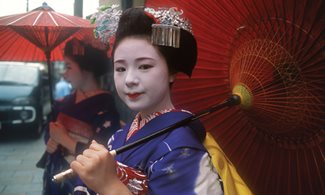
If Japan had anything as pedestrian as a mascot, it might very well be an elegant
Geisha, resplendent in her traditional silk robes, elaborate coiffure, and stylized make-up. This 400-year tradition of professional entertainment is often misunderstood by foreigners, who tend to confuse
Geisha with courtesans or modern-day call girls. In fact, they are a highly-competitive, rather secretive guild of skilled practitioners of the traditional Japanese arts of flower arrangement, calligraphy, conversation, stylized dancing, execution of the symbolic but deceptively simple tea ceremony, and playing the three-stringed
shamisan. Although the number of
Geisha is dwindling, they are still very much a key element in Japanese leisure and entertainment and can be found in many large Japanese cities, and most particularly in Tokyo, Kanazawa, and the ancient capital of Kyoto, which is known for its well-preserved
Geisha districts.
Becoming a
Geisha takes years of practice. In previous centuries, young girls were sold into virtual slavery to
Geisha houses known as
olyeya. Set on the bottom rung of a demanding apprenticeship, these young trainees known as
Hanamachi or
Maiko (literally “young dancer”) were obliged to serve as maids to the older and more experienced
Geisha of the house. Once successful apprentices graduated to
Minari status, they were accompanied by a more experienced
On-see or “older sister,” on engagements. If a
Minari mastered all of the necessary refinements, she became a full-fledged
Geisha, as they are known in Tokyo or
Geiko in Kyoto. Contemporary
Geisha training is almost as rigorous as that of the nineteenth century, described by Arthur Golden in his novel
Memoirs of a Geisha (later made into a popular film) and many young women are eschewing the rigor, discipline, and necessary asceticism of a
Maiko apprenticeship for conventional business careers.
Still many do persist, and if you are strolling around the Gion neighborhood of Kyoto in early evening, you may well catch sight of a
Geiko or
Maiko heading to an engagement. They are instantly recognizable by their traditional attire of a silk obi and kimono and the tap-tap on the cobblestones of their signature red clogs, raised on high wooden platforms. Their make-up is highly stylized — the heavy flat-white foundation and bright red lips evoking traditional Japanese ideas of classical beauty. The crowning glory, of course, is their hair, which is piled up in elaborate coiffures and secured with exquisite jeweled accessories that are rotated according to the season.
Alexander + Roberts visit the
Geiko quarters of Japan’s ancient capital Kyoto on a number of curated itineraries such as our escorted
From Japan’s Inland Sea to the Alps and the independent
Kyoto package. Speak to one of our knowledgeable reservation agents to learn more.